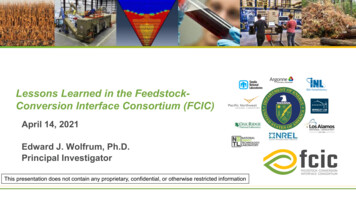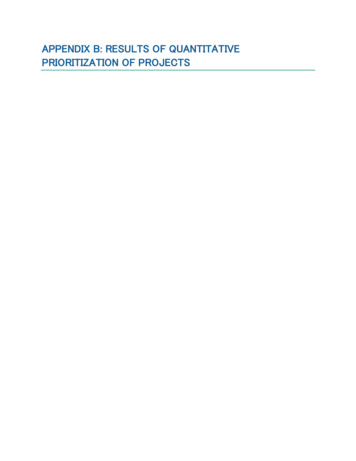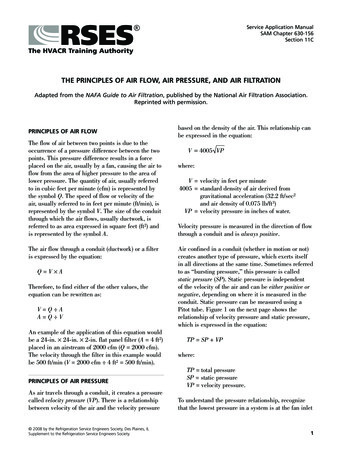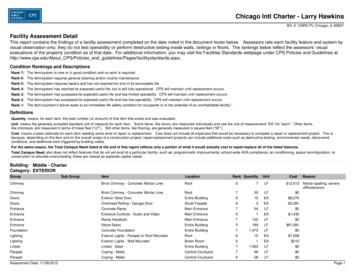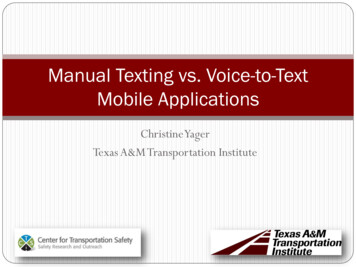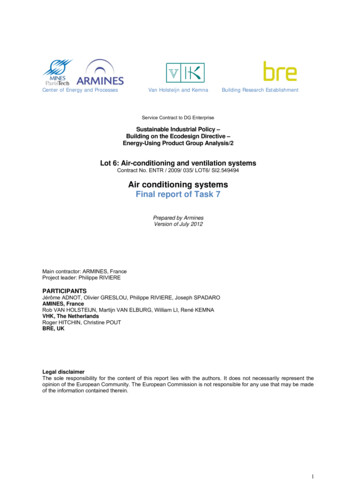
Transcription
Center of Energy and ProcessesVan Holsteijn and KemnaBuilding Research EstablishmentService Contract to DG EnterpriseSustainable Industrial Policy –Building on the Ecodesign Directive –Energy-Using Product Group Analysis/2Lot 6: Air-conditioning and ventilation systemsContract No. ENTR / 2009/ 035/ LOT6/ SI2.549494Air conditioning systemsFinal report of Task 7Prepared by ArminesVersion of July 2012Main contractor: ARMINES, FranceProject leader: Philippe RIVIEREPARTICIPANTSJérôme ADNOT, Olivier GRESLOU, Philippe RIVIERE, Joseph SPADAROAMINES, FranceRob VAN HOLSTEIJN, Martijn VAN ELBURG, William LI, René KEMNAVHK, The NetherlandsRoger HITCHIN, Christine POUTBRE, UKLegal disclaimerThe sole responsibility for the content of this report lies with the authors. It does not necessarily represent theopinion of the European Community. The European Commission is not responsible for any use that may be madeof the information contained therein.1
ContentsTASK 7 – POLICY AND IMPACT ANALYSIS. 3INTRODUCTION . 3Purpose of this report . 3Report organisation . 47.1. POLICY OPTIONS. 5Introduction. 57.1.1.Definition of products and scope . 77.1.2.Performance indicators and existing standards . 187.1.3.Energy efficiency and CO2 requirements . 247.1.4.Other Ecodesign requirements . 567.1.5.Alternative policies . 707.2. IMPACT ANALYSIS . 717.2.1.Description of the scenarios . 717.2.2.Savings and impacts in the different scenarios . 737.2.3.Impacts on the main actors . 82CONCLUSION . 89TASK 7 REFERENCES . 91LIST OF FIGURES . 93LIST OF TABLES . 932
INTRODUCTIONThis is the draft report for Task 7 on the Air Conditioning Systems, as part of the preparatory study onAir Conditioning and Ventilation Systems in the context of the Ecodesign Directive: ‘ENTR Lot 6 – AirConditioning and Ventilation Systems’. This study is being carried out for the EuropeanCommission (DG ENTR). The consortium responsible for the study is Armines (lead contractor), BREand VHK. The underlying report has been written by Armines.PURPOSE OF THIS REPORTAs laid out in previous Task reports, this product group is eligible for Ecodesign measures as itcomplies with the criteria of Art. 15 of the 2009/125/EC directive. It is economically andenvironmentally significant. There is a significant cost-effective saving potential that is not captured.The general objective is to develop a policy which corrects the market and regulatory failures followingthe task 7 description as given in the methodology and reproduced below.SCOPE: This task looks at suitable policy means to achieve the potential improvement, e.g.implementing LLCC as a minimum requirement, the environmental performance of BAT or BNAT as abenchmark, using dynamic aspects, legislative or voluntary agreements, standards, labelling orincentives, relating to public procurement or direct and indirect fiscal instruments.It draws up scenarios 1990–2025 quantifying the improvements that can be achieved versus aBusiness-as-Usual scenario and compares the outcomes with EU environmental targets, the societalcosts if the environmental impact reduction would have to be achieved in another way, etc.It makes an estimate of the impact on users (purchasing power, societal costs) and industry(employment, profitability, competitiveness, investment level, etc.), explicitly describing and taking intoaccount the typical design cycle (platform change) in a product sector.In addition the contractor should provide an analysis of which significant impacts may have to bemeasured under possible implementing measures, and what measurement methods would need to bedeveloped or adapted.Subtask 7.1 - Policy AnalysisThe policy analysis should identify policy options considering the outcomes of all previous tasks,notably the options should:- Be based on the exact definition of the products, according to subtask 1.1 and modified/ confirmedby the other tasks;- Provide ecodesign requirements, such as minimum (or maximum) requirements1, considering thesensitivity analysis carried out in subtask 6.4;- Be complemented, where appropriate, with (dynamic) labelling and benchmark categories linked topossible incentives, relating to public procurement or direct and indirect fiscal instruments;- Where appropriate, apply existing standards or propose needs/ generic requirements for harmonisedstandards to be developed;- Provide measurement requirements, including measurement standards and/or methods;- Consider possible self-regulation, such as voluntary agreement or sectoral benchmarks initiatives;- Provide requirements on installation of the product or on user information.Subtask 7.2 - Impact AnalysisFor each of the policy options defined in subtask 7.1, the costs and benefits should be assessed. Inparticular, the ecodesign requirements should not entail excessive costs nor undermine thecompetitiveness of European enterprises and should not have a significant negative impact onconsumers or other users. This encompasses the assessment of the following impacts:1Ecodesign requirements should always address improvements in terms of environmental performance, not in terms oftechnologies.3
- Monetary impacts for categories of users in particular as regards affordability and life cycle cost ofthe product (confirming or modifying the results obtained in subtask 6.1);- Impacts on the functionality of the product, from the perspective of the user;- Monetary impacts on the manufacturer regarding redesign, testing, investment and/or productioncosts (confirming or modifying the results obtained in subtask 6.1);- Further impacts on manufacturers, such as imposed proprietary technology or administrativeburdens;- Impact on the competitive situation of the market; such as market share of products alreadycomplying with the envisaged minimum requirement, market shares of remaining models after theminimum requirement is introduced, competitive advantage or negative impacts on the competitivesituation of some market players (e.g. SMEs, regional players) or reduction in user choice;- Impacts on EU firms’ competitiveness outside the EU and on importers;- Impact on innovation or research and development;- Any significant social impact, such as impacts on employment and labour conditions, health andsafety or equality of treatment and opportunities.REPORT ORGANISATIONThe report follows the task structure outlined in the methodology and reported above.In the task 7.1, the scope and definitions are reviewed. The performance indicators proposed andstandardization requirement are discussed. On this basis, policy options regarding the mainenvironmental impacts of these products are proposed, as well as complementary measures regardinginformation requirements and other environmental impacts.In the task 7.2, the hypothesis of the scenarios are described and their impact are evaluated. Asregards the operational objectives it is clear that the 2020 time horizon, used in several overarchingpolicy objectives for energy security of supply and environment, is very important. Savings in 2020,with respect to the reference year 1990, indicate the relative contribution of measures, although theseimpacts are computed up to 2025. In addition, likely impacts on the product functionality, on the users,manufacturers and utilities are described.4
7.1. POLICY OPTIONSINTRODUCTIONThe table below gives the list of all possible combinations by main product type (chiller, air conditioner ), packaging (package, split, VRF, ), principle of operation (electric vapor compression type,absorption ) and sink type of products in the scope of the ENTR Lot 6 study and proposedmeasures.Table 7 - 1 . Summary of the scope and analysis performed in the previous tasksEvaluation of theimprovement potentialDescription of products in the scope of ENTR Lot 6 studyProduct categoryPackagingCooling principlePackage, splitElectricAir conditioning chillersPackagePackage, splitAir conditionersPackageAbsorption /adsorptionSplit, multi‐splitElectricSplit, multi‐splitGas engine ricBase casesin Task ater‐cooledNoNoGas engine liquid coolerElectricN/ANoNoOpen cooling towerElectricN/ANoNoN/AElectricN/AYesNoPackageFan coil unitsGas engine vaporcompressionPackage (incl. Rooftop)Air conditioningcondensing unitHeat rejection unitsGas engine vaporcompressionSink typeN/A: not applicable5
This table is limited to products thought to be presently available on the EU market. However, some ofthe combinations for which there is no available products (evaporatively-cooled electric air conditionerfor instance) could be populated in the short term and should be considered at least forstandardization purpose.Given the very high number of products in scope, the study focused its efforts on the modeling of avery limited number of base cases, which are thought to represent more than 95 % of the totalenvironmental impacts of ErP products in comfort air conditioning systems in Europe (out of the scopeof the 2012/206/EC regulation ie only accounting air-to-air conditioners above 12 kW).These base cases are:- Air conditioning chillers1. An air cooled electric chiller of 100 kW cooling output,2. An air cooled electric chiller of 400 kW cooling output,3. A water-cooled electric chiller of 100 kW cooling output,4. A water-cooled electric chiller of 1000 kW cooling output,- Air conditioners5. An electric split air conditioner of 14 kW cooling output,6. An elecric VRF air conditioner of 50 kW cooling output,7. An electric rooftop package air conditioner of 80 kW cooling output,- Air conditioning condensing unit- Terminal units8. A fan coil unit of 3 kW cooling output- Heat rejection units9. A dry-cooler of 200 kW cooling output10. Cooling tower of 1000 kW cooling ouput (representative of the stock of cooling towers installed, nobase case made for the sales)Cooling generatorsAn economic optimization was performed in task 6 for the seven base cases representing the coolinggenerators, ie the first five base cases above. Altogether they are believed to represent more than 90% of the total environmental impact of ErP products in comfort air conditioning systems in Europe (outof the scope of the 2012/206/EC regulation).For these base cases, the LLCC and BAT were determined in view of requiring specific energyefficiency and TEWI minimum performance values following Task 6 results. In part 7.1.3, the possibletargets regarding energy efficiency and equivalent CO2 emissions minimum requirements arediscussed for electric air conditioning chillers (air-cooled and water-cooled) and electric airconditioners (air-to-air above 12 kW).It is clear that when having in view a regulation for the whole sector, it is not possible to exclude frompossible measures, products that represent even a very low market share as it could lead to biaise themarket. Hence, all cooling generators in scope should be included in the scope of the measures.However, the environmental impact of the other cooling generators than electric air conditioningchillers (air-cooled and water-cooled) and electric air conditioners (air-to-air above 12 kW) is estimatedto be very low because of low sales. This regards mainly water-cooled air conditioners, gas-engine airconditioners and absorption chillers.In addition, water-cooled air conditioners, which could be in competition with air-to-air air conditioners,are inherently more efficient, because of more favorable temperature levels at the condenser, and arealso structurally more expensive, as they need a cooling tower, or a geothermal/acquifer heatexchanger. Hence, a major market change does not seem likely. The same rationale applies toabsorption chillers, which correspond to a niche market.Thus, for other cooling generators than the electric or gas engine air-cooled and water-cooled chillersand air-to-air air conditioners, it is proposed to include them in the scope of the measures, to requirestandards to be developed, to add also the same other requirements, regarding sound powermaximum levels, resource efficiency and information requirements but not to ask for specificrequirements. This is the case of water-cooled air conditioners and absorption chillers.6
Heat rejection and terminal unitsThe study team did not proceed with the economic optimization of terminal and heat rejection units.The main reason for that choice is that more efficient system designs do not match with the choice ofmore efficient products in that case: for instance, the gain in the fan power consumption of using ahighly efficient dry cooler would still lead to higher energy consumptions at system level than choosinga cooling tower. The reason is that the cooling tower would lead to 20 K lower condensing temperatureat the condenser of the water cooled chiller, which makes much more gains on the energyconsumption of the cooling generator than the potential fan motor consumption reduction.Nevertheless, it is proposed to include heat rejection units and terminal units in the scope of a possibleimplementing measure, to improve the standards and ask for the other than specific requirements,regarding sound power maximum levels, resource efficiency and information requirements7.1.1. DEFINITION OF PRODUCTS AND SCOPEScope overviewThe study scope has been defined in Task 1 of this study as follows.The focus is on air conditioning systems in human occupied buildings to ensure comfort airconditioning. The Energy Related Products in this preparatory study are themselves a complete airconditioning system that ensures a cooling function for comfort purposes, or are part of air conditioningsystems that supply this function.The cooling products that ensure this main function are cooling cycles that can extract heat directlyfrom a room and reject it directly to the outside of the building. In that case, they are called air-to-air airconditioners, on the basis of the names of the sink (outside air) and source (indoor air) they use.Whether the heat is still directly extracted from the room but then rejected at the condenser by othermeans, these products can be called water-to-air or evaporatively-cooled-to-air air conditioners,depending thus on the sink type.Whether the heat extraction is made by an intermediary water-to-air heat exchanger, the heat is thenrejected outside by a chiller. As for air conditioners, a chiller can be air-cooled, water-cooled orevaporatively-cooled.Consequently, all the sink-source combinations are included in the study:- air-to-air air conditioner,- water-to-air air conditioner- evaporatively-cooled-to-air air conditioner,- air-to-water chiller,- water-to-water chiller- evaporatively-cooled-to-water chiller,Concerning air conditioners, in some cases, a unit can be sold without the indoor refrigerant-to-aircooling coil (and its associated indoor fan), in which case it is called a condensing unit (in other terms,a condensing unit contains the condenser heat exchanger and its fans, the compressor(s) and theexpansion valve that any air conditioner is equipped with, the only difference being that it does notcontain the indoor heat exchanger). The fitting with the refrigerant coil must therefore be made on site.As for other air conditioners, a condensing unit can be air cooled, water cooled or evaporativelycooled. In larger capacity ranges, these air conditioning condensing units are adapted from chillers(sold without the refrigerant to water heat exchangers).Note : to avoid any confusion, the term “coil” is a synonym of “heat exchanger”In the same way, chillers may be sold without a condenser (outdoor heat exchanger with its fans if it isof an air-cooled type, and without fans if it is of another sink type and are then logically calledcondenserless products.7
Each air conditioning system type is composed of a large number of components. Nevertheless, thenumber of energy using products in these systems is limited. Hence, the Lot 6 scope can besummarized by main energy using product type as follows:1. Air conditioners- Package air conditioner [air-to-air 12 kW, water-to-air, evaporatively cooled] and- Split and multi split air conditioners [air-to-air 12 kW, water-to-air, evaporatively cooled]- VRF systems (a split system where the expansion of the refrigeration occurs in the indoor units andnot in the outdoor unit) [air-to-air 12 kW, water-to-air, evaporatively cooled]2. Chillers for air conditioning applications [air-to-water, water-to-water, evaporatively-cooled,condenserless]3. Air conditioning condensing units [air-to-water, water-to-water, evaporatively-cooled]4. Terminal units to extract heat from the space to be conditionedFan coils5. Heat rejection units means from the cooling systemCooling towersEvaporatively-cooled liquid coolerDry coolersProduct definitionsThe definitions of the products in the scope of Lot 6 study are given below.Air conditionerAn ‘air conditioner’ means a device capable of cooling or heating, or both, conditioned air for humancomfort, using a vapour compression cycle driven by an electric compressor or by an engine drivencompressor, including air conditioners that provide additional functionalities such as dehumidification,air-purification, ventilation or supplemental air-heating by means of electric resistance heating or bythe combustion of gaseous or liquid fossil fuel. An air conditioner releases the heat extracted from theconditioned air to ambient air, water or ground source; this definition also includes appliances that mayuse water for evaporation on the condenser (either condensate that is formed on the evaporator sideor externally added water), as well as appliances that may use water (either condensate water that isformed on the evaporator side or externally added water) for evaporation on the condenser.The definition in the regulation EC 206/2012 is reproduced below :‘air conditioner’ means a device capable of cooling or heating, or both, indoor air, using a vapourcompression cycle driven by an electric compressor, including air conditioners that provide additionalfunctionalities such as dehumidification, air-purification, ventilation or supplementalair-heating by means of electric resistance heating, as well as appliances that may use water (eithercondensate water that is formed on the evaporator side or externally added water) for evaporation onthe condenser, provided that the device is also able to function without the use of additional water,using air only;Several differences are to be noted:- “indoor” has been replaced with “conditioned air” as the air treated by air conditioners may also bepartly fresh air,- it is also proposed to limit the definition to comfort application as specific air conditioners for otherpurpose have not been studied here, ie to exclude close control air conditioners,- gas engine air conditioners are included,- other than electric complementary heating means are integrated,8
- the sentence “provided that the device is also able to function without the use of additional water,using air only” has been removed as there is no reason this should not be the case.Additionally, only air-to-air air conditioners with a design cooling capacity greater than 12 kW areincluded in the study.Note : nothing prevents that air conditioners may be based on absorption/adsorption cycles exceptthere is presently no such unit on the market nor being developed to the knowledge of the study team.If necessary, the definition could be extended to cover these products.Air conditioning chillerA “chiller” means a device which meets all of the following criteria:- it extracts heat from a water-based central cooling system in order to reach and maintain the indoortemperature of an enclosed space such as a building, a dwelling, or a room, at a desired level;- it uses a cooling generator based on one of the following processes: a vapour compression cycle driven by an electric compressor a vapour compression cycle with a compressor driven by a motor engine an absorption cycle whose heat is supplied by the combustion of gaseous or liquid fossilfuels or by waste heat;- it releases the heat extracted from the enclosed space to ambient air, water or ground source; thisdefinition also includes appliances that may use water for evaporation on the condenser andcondenserless units.It can also supply heating as a “boiler” and in that case is called a reversible chiller/heat pump.Regarding boiler, the provisional definition of the draft boiler regulation is used here:(1) “boiler” means a device which meets all of the following criteria: it provides heat to a water-based central heating system in order to reach and maintain theindoor temperature of an enclosed space such as a building, a dwelling, or a room, at adesired level; it uses a heat generator using the processes listed in point (2);(2) “heat generator” means the part of a boiler that generates the heat using the following processes: combustion of gaseous or liquid fossil fuels; use of the Joule effect in electric resistance heating elements; capture of ambient heat from air, water or ground source, and/or waste heat;(3) “water-based central heating system” means a system using water as heat transfer medium todistribute centrally generated heat to heat emitters for space heating of buildings, or parts thereof.Air conditioning condensing unitAn air conditioning condensing unit means a device designed to provide refrigerant to a cooling coilwhich ensures the delivery of conditioned air to an enclosed space (room for instance), enabling thecoil of cooling and/or heating this air, and which is based on the vapour compression cycle. It is drivenby an electric compressor or by an engine driven compressor.An air conditioning condensing unit releases the heat extracted from the conditioned air to ambient air,water or ground source; this definition also includes appliances that may use water for evaporation onthe condensor (either condensate that is formed on the evaporator side or externally added water.Terminal unitsRoom fan-coil unitA factory-made assembly which provides one or more of the functions of forced circulation of air,heating, cooling, dehumidification and filtering of air, but which does not include the source of coolingor heating. This device is normally designed for free intake of air from a room and delivery of air intothe same room, but may be applied with minimal ductwork. This device may be designed for built inapplication, or with an enclosure for application within the conditioned space.9
Heat rejection unitsHeat rejection unitA self contained system that cools a single phase liquid by rejecting sensible and/or latent heat via awater to air heat exchanger, the air being mechanically circulated by one or several fans.Scope limitations due to other ecodesign studies and regulationsAir-to-air air conditioners below 12 kW cooling capacity are included in the ENER Lot 10 study and arecovered by the regulation EC/206/2012. Hence, air-to-air air conditioners with cooling capacity below12 kW are not included here. In addition, this regulation gives a reference in order to proposerequirements above 12 kW, regarding minimum energy efficiency requirements, performanceindicators used and tolerances, as well as regarding noise. These references will be discussedhereafter.For chillers, they were not included in the ENER Lot 10 preparatory study, and consequently there isno lower capacity limit.Chillers for other purpose than (comfort) air conditioning, meaning refrigeration and process cooling,are already included in the ENTR Lot 1 preparatory study and the consequently planned measures.Hence, other than air conditioning chillers are not concerned by the measures here.Part of the cooling generators, which term encompasses air conditioners and chillers, are reversible.For reversible air-to-air conditioners below 12 kW, their heating function is included in the regulationEC/206/2012. Above 12 kW, the heating function has been the subject of the ENER Lot 21preparatory study on central heating products using hot air to distribute heat (other than CHP).Both ENTR Lot 6 and ENER Lot 21 preparatory studies have been led in parallel. The main reason totreat separately the heating function is that there are other central heating solutions using hot air thanjust reversible air conditioners. Hence, it was decided all heating products should be comparedregarding their heating function in ENER lot 21 and that the cooling function of reversible productsshould be studied in the air conditioning ENTR Lot 6 study.The ENER Lot 21 builds upon the regulation 2012/206/EC on smaller than 12 kW air conditioners inorder to define a seasonal coefficient of performance (SCOP) and eventually proposes SCOP specificrequirements. In ENTR Lot 6, specific requirements are based on the seasonal energy efficiency ratioin cooling mode. For reversible products however, a matching SCOP value is indicated (with bivalentpoint at – 7 C, as for the ENER Lot 10 study).As the energy consumption for cooling is lower than the one for heating, the ambition of the coolingrequirements (and corresponding heating SCOP values) is likely to be lower than the heatingrequirements set in ENER lot 21. However, at the end, a single measure is planned for airconditioners, whether reversible or not, and the final implementing measure (if any) should setharmonized requirements from these two studies.For reversible water/brine-to-air air conditioners below 12 kW, the products were included in the ENERLot 20 study. The same rationale as for ENER Lot 21 applies.For reversible chillers, their heating function has been included into the ENER lot 1 study on waterbased heating systems. The planned energy efficiency minimum requirements apply up to 400 kWrated capacity in standard rating conditions, both for floor and radiator based applications (whichwould result in different cooling capacities for the same chiller). It should be noticed that part of thereversible chillers may have a much higher heating capacity (up to 800 kW for air cooled chillers, andhigher than 1500 kW for water cooled chillers). The planned measures on water based heatingsystems also contain noise requirements up to 70 kW heating capacity, to be discussed hereafter forLot 6 products.10
Screening of the environmental impacts of products in scopeGlobal environmental impactThe environmental impacts of air conditioning products in the scope of ENTR Lot 6 have beencomputed in Task 4, taking into account their conditions of installation (system/building/climate) and alltheir life cycle phases.Energy consumption constitutes the greatest part of the environmental impacts of air conditioningproducts, the second largest impact being the direct equivalent CO2 emissions due to the losses ofrefrigerant fluids of electrically driven vapour compression cycles.For 2010, which is taken as a reference year, the stock of products in scope is estimated to consume97 TWh/y, including the heating function of reversible air conditioners, and probably a little more than110 TWh/y if the heating function of reversible chillers is also included. This electricity consumptioncorresponds respectively to about 40 MtCO2eq/y and 45 MtCO2eq/y.In addition, it is estimated that between 4 and 1
of the 2012/206/EC regulation ie only accounting air-to-air conditioners above 12 kW). These base cases are: - Air conditioning chillers 1. An air cooled electric chiller of 100 kW cooling output, 2. An air cooled electric chiller of 400 kW cooling output, 3. A water-cooled electric chiller of 100 kW cooling output, 4.

